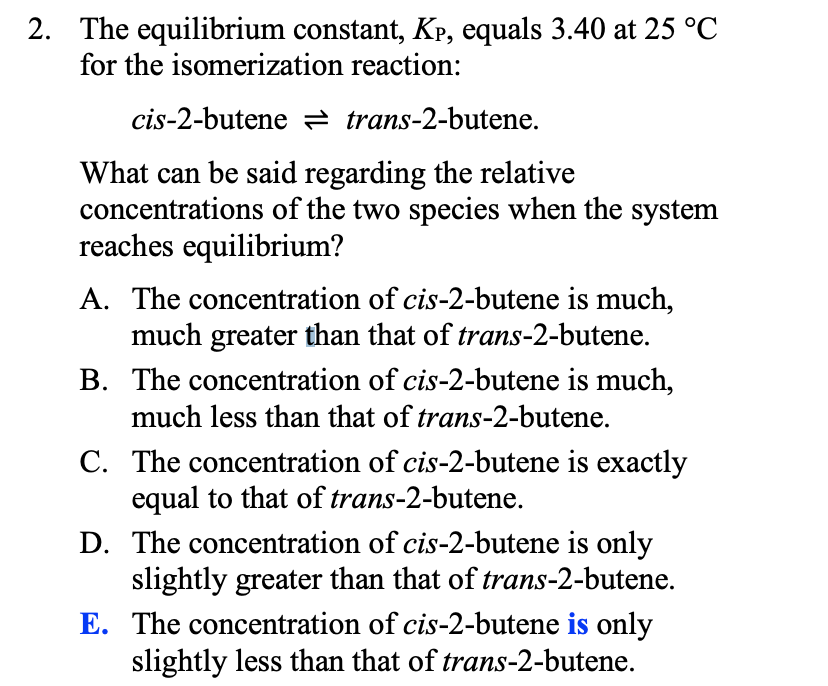2. The equilibrium constant, Kp, equals 3.40 at 25 °C for the isomerization reaction: cis-2-butene 2 trans-2-butene. What can be said regarding the relative concentrations of the two species when the system reaches equilibrium? A. The concentration of cis-2-butene is much, much greater than that of trans-2-butene. B. The concentration of cis-2-butene is much, much less than that of trans-2-butene. C. The concentration of cis-2-butene is exactly equal to that of trans-2-butene. D. The concentration of cis-2-butene is only slightly greater than that of trans-2-butene. E. The concentration of cis-2-butene is only slightly less than that of trans-2-butene.
2. The equilibrium constant, Kp, equals 3.40 at 25 °C for the isomerization reaction: cis-2-butene 2 trans-2-butene. What can be said regarding the relative concentrations of the two species when the system reaches equilibrium? A. The concentration of cis-2-butene is much, much greater than that of trans-2-butene. B. The concentration of cis-2-butene is much, much less than that of trans-2-butene. C. The concentration of cis-2-butene is exactly equal to that of trans-2-butene. D. The concentration of cis-2-butene is only slightly greater than that of trans-2-butene. E. The concentration of cis-2-butene is only slightly less than that of trans-2-butene.
Chemistry & Chemical Reactivity
9th Edition
ISBN:9781133949640
Author:John C. Kotz, Paul M. Treichel, John Townsend, David Treichel
Publisher:John C. Kotz, Paul M. Treichel, John Townsend, David Treichel
Chapter15: Principles Of Chemical Reactivity: Equilibria
Section: Chapter Questions
Problem 38GQ: At 2300 K the equilibrium constant for the formation of NO(g) is 1.7 103. N2(g) + O2(g) 2 NO(g)...
Related questions
Question

Transcribed Image Text:2. The equilibrium constant, Kp, equals 3.40 at 25 °C
for the isomerization reaction:
cis-2-butene 2 trans-2-butene.
What can be said regarding the relative
concentrations of the two species when the system
reaches equilibrium?
A. The concentration of cis-2-butene is much,
much greater than that of trans-2-butene.
B. The concentration of cis-2-butene is much,
much less than that of trans-2-butene.
C. The concentration of cis-2-butene is exactly
equal to that of trans-2-butene.
D. The concentration of cis-2-butene is only
slightly greater than that of trans-2-butene.
E. The concentration of cis-2-butene is only
slightly less than that of trans-2-butene.
Expert Solution
This question has been solved!
Explore an expertly crafted, step-by-step solution for a thorough understanding of key concepts.
This is a popular solution!
Trending now
This is a popular solution!
Step by step
Solved in 2 steps with 1 images

Recommended textbooks for you

Chemistry & Chemical Reactivity
Chemistry
ISBN:
9781133949640
Author:
John C. Kotz, Paul M. Treichel, John Townsend, David Treichel
Publisher:
Cengage Learning

Chemistry & Chemical Reactivity
Chemistry
ISBN:
9781337399074
Author:
John C. Kotz, Paul M. Treichel, John Townsend, David Treichel
Publisher:
Cengage Learning

Chemistry: The Molecular Science
Chemistry
ISBN:
9781285199047
Author:
John W. Moore, Conrad L. Stanitski
Publisher:
Cengage Learning

Chemistry & Chemical Reactivity
Chemistry
ISBN:
9781133949640
Author:
John C. Kotz, Paul M. Treichel, John Townsend, David Treichel
Publisher:
Cengage Learning

Chemistry & Chemical Reactivity
Chemistry
ISBN:
9781337399074
Author:
John C. Kotz, Paul M. Treichel, John Townsend, David Treichel
Publisher:
Cengage Learning

Chemistry: The Molecular Science
Chemistry
ISBN:
9781285199047
Author:
John W. Moore, Conrad L. Stanitski
Publisher:
Cengage Learning

Chemistry
Chemistry
ISBN:
9781305957404
Author:
Steven S. Zumdahl, Susan A. Zumdahl, Donald J. DeCoste
Publisher:
Cengage Learning


Chemistry: An Atoms First Approach
Chemistry
ISBN:
9781305079243
Author:
Steven S. Zumdahl, Susan A. Zumdahl
Publisher:
Cengage Learning